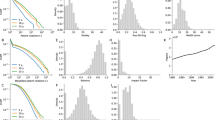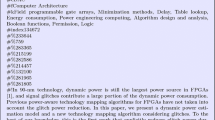Abstract
Two indicators regarded to reflect the status of disciplinary differentiation were assessed through citation analysis. Adoption of scientific innovations (publications utilizing new scientific information) and interdisciplinary linkages (percentage of total publications of single disciplines which are cross-referenced by other disciplines) were investigated in selected biological professions. Findings indicated: 1) a significant delay in the use of innovations and a significant difference in the emphasis of interdisciplinary linkages in several professions and disciplines; 2) faster adoption of innovations and greater interdisciplinary linkages in areas with broader disciplinary contents; 3) an inter-personal communication pattern; and 4) slower adoption in applied than in basic fields.
Similar content being viewed by others
References
R. G. Havelock,Planning for innovation: through the dissemination and utilization of knowledge. Center for Research on utilization of scientific knowledge. Institute for Social Research, University of Michigan, Ann Arbor. 1969.
E. M. Rogers,Diffusion of innovations. Fourth Edition. The Free Press (Collier Macmillan Publishers). New York. 1995.
B. Ryan, N. C. Gross, The diffusion of hybrid seed corn in two Iowa communities.Rural Sociology, 8 (1943), 15–24.
J. Mezirow,Transformative dimensions of adult learning. Jossey-Bass, San Francisco, CA. 1991.
G. Köhler, C. Milstein, Continuous culture of fused cells secreting antibody of predefined specificity.Nature, 236 (1977), 495–497.
H. M. Shapiro, Fluorescent dyes for differential counts by flow cytometry: does histochemistry tell us much more than cell geometry?J. Histochem. Cytochem., 25 (1977) No. 8, 976–989.
R. K. Saiki et al., Enzymatic amplification of β-globin genomic sequences and restriction site analysis for diagnosis of sickle cell anemia.Science, 230 (1985), 1350–1354.
M. J. Norusis, SPSS/PC+. Chicago. 1986.
A. L. Rivas et al., Functions of veterinary colleges and orientations of professional practice in the Americas.J. Am. Vet. Med. Assoc. 208 (1996) No. 10, 1630–1635.
R. W. Nichols, Health: choices, choices, choices.The Sciences, 36 (3): 4. May/June 1996.
J. D. Novak, D. B. Gowin,Learning how to learn. Cambridge University Press. 1984.
C. P. Snow,The two cultures and the scientific evolution. Cambridge University Press. New York. 1961.
Author information
Authors and Affiliations
Rights and permissions
About this article
Cite this article
Rivas, A.L., Deshler, D., Colle, R.D. et al. Indicators of disciplinary differentiation: Interdisciplinary linkages and adoption rate of biological innovations. Scientometrics 37, 63–86 (1996). https://doi.org/10.1007/BF02093485
Received:
Issue Date:
DOI: https://doi.org/10.1007/BF02093485




